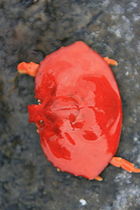Cryptolithodes stichensis
From ize2010
The Turtle Crab
| Turtle Crab | |
|---|---|
| Scientific classification | |
| Kingdom: | Animalia |
| Phylum: | Arthropoda |
| Subphylum: | Crustacea |
| Class: | Malacostraca |
| Order: | Decapoda |
| Suborder: | Pleocyemata |
| Family: | Lithodidae |
| Genus: | Cryptolithodes |
| Species: | sitchensis |
| Binomial name | |
| Cryptolithodes sitchensis Brandt, 1853[1] |
|
Visit my widipedia site. [1]
Contents |
Description
Cryptolithodes stichensis has a half-moon shaped carapice that extends over all of its eight walking legs and two cheliped, giving them their common names of “turtle”, “umbrella” or “helmet” crab. The Carapace can be 5-10cm at the adult stage and has scalloped edges. This carapace ranges from neutral “sandy” colors to bright oranges, reds, and purples[2]. The rostrum, or “head spike”, of the carapace fans out distally from the crab looking like a nose. From above only the eyes and second antennae are visible. The ventral side is commonly white in color, and the abdomen is protected my multiple hard plates that lack raised margarines[3]. The chelipeds are smooth. And the fifth pair of walking legs are located at the posterior and are difficult to distinguish.[4]
Range
Cryptolithodes stichensis can be found from southern Alaska to southern California. They live within 18m of the intertidal zone along the exposed coasts of the Pacific Ocean.[4]Intertidal species of Lithodidae prefer habitats of cooler temperatures ranging from 0 to 25 oC (32-77oF) and temperatures of 16 oC (61oF) during stages of larval development. This causes a restriction on their distribution as water temperatures change due to global warming.[5]
Identification
The distinguishing characteristic between C. sitchensis and C. typicus is that C. sitchensis has a rostrum that is wider distally than proximally while the opposite is found in C. typicus. Also, C. typicus has raised margins of the abdominal segments while C. sitchensis does not. [3]
Life History
The larval development of C. sitchensis is characteristic of having six tergites at the megalopal stage. Upon reaching the adult stage the first and second abdominal segments have fused and the 6th tergite and telson are whole. Male and female C. sitchensis have symmetrical abdomens, yet females have a greater number of accessory plates on the left side of the third tergite.[5]
Natural History
Cryptolithodes stichensis may be hard to spot due to its rough, rock-like exterior, but is easily caught due to it’s slow movements. Found most commonly in the intertidal zone, the “turtle crab” feeds on coralline algae. This maybe the reasoning for the diverse colorations of it’s carapace to camouflage with its surroundings.[1]
Threats
Natural Predators of C. sitchensis include larger marine invertebrates like octopus, as well as sea birds, and marine mammals like otters.
A major threat to C. sitchensis in Southern California is Deforestation and its effects on the Giant Kelp forests between the Cannle Islands National Park. The Giant Kelp Forests of Macrocystis pyrifera for a protective canopy fosetering the ideal temperature for various species that are temperature sensitive, such as C. sitchensis, and the growth of macroalgea and corallines needed for their survival.[3]
References
- ↑ 1.0 1.1 http://www.wallawalla.edu/academics/departments/biology/rosario/inverts/Arthropoda/Crustacea/Malacostraca/Eumalacostraca/Eucarida/Decapoda/Anomura/Family_Lithodidae/Cryptolithodes_sitchensis.html
- ↑ Sea Shore Life of the North Pacific Coast by Eugene N. Kozloff pg. 192 & 255
- ↑ 3.0 3.1 3.2 Marine Invertebrates of the Pacific Northwest by Eugene N. Kozloff pg. 407
- ↑ 4.0 4.1 Marine Life of the Pacific Northwest by Andy Lamb and Bernard Hanby pg. 313
- ↑ 5.0 5.1 http://si-pddr.si.edu/dspace/bitstream/10088/7369/1/IZ_Lemaitre2000AspectsofEvolution.pdf

